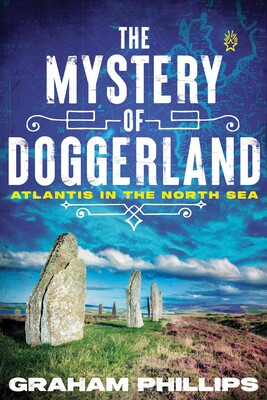|
The Mystery of Doggerland: Atlantis in the North Sea
By Graham Phillips Published in July 2023 225 Pages Thibault’s Score: 4/5 The cover and title of the book made me expect some weird new age book. Instead, it turned out to be a very well written and mainstream scientific account of Doggerland. In the 1930s, Flemish fishing boats known as “Doggers” started deep sea trawling. To the surprise of the sailors, they started fishing up mesolithic artifacts such as statues, harpoons, and spearheads. Historians then began theorizing that a landmass, where humans had lived, had once existed under the North Sea, which they called Doggerland. For decades, the existence of Doggerland was controversial. However, the science was overturned in the 1990s due to improvements in sediment studies and underwater archeology. Now both the existence of Doggerland and the human presence on Doggerland have been conclusively proven. Note - for historical facts, I use BC in this book review (Before Christ / Before Common Era) and for geological facts I use BP (before present). The book does this too. Around 17,000 BP, during the height of the ice age, the world looked very different. Large amounts of water were trapped in the polar ice caps, which extended far lower than they do today. As a result, the sea levels were much lower. A large landmass, located in what is today the North Sea, connected Britain, Ireland, Denmark, the Netherlands, Sweden, and Norway by land. Doggerland started sinking around 17,000 BP due to rising sea levels. Every year, Doggerland lost between one and two meters. By around 10,000 BP Doggerland had transformed into an island to the East of Britain roughly the size of Ireland. Archaeologists and geologists refer to this island as “Dogger Bank” to distinguish it from the larger landmass that was connected by land to the European continent. The island of Dogger Bank developed a thriving human civilization. Many artifacts from this civilization have been found as a result of offshore drilling in the early 2000s and the construction of offshore wind farms in the early 2020s. These artifacts reveal that the civilization was far more advanced than what existed in Europe at the time. Although it is controversial, some archeologists even think that the Doggerlanders had started experimenting with early metallurgy. Direct evidence for human civilization on Dogger Bank is limited. In addition to artifacts, there have also been underwater radar surveys. These have revealed that there are underwater megaliths similar to stonehenge. There are also signs of clearcutting and deforestation, which are often accompanied by agriculture. There is also fascinating indirect evidence. Around 8000 BP, a devastating tsunami submerged almost the entirety of Dogger Bank for several days. The tsunami was caused by melting sea ice in Norway. Evidence of this tsunami can be found along the entire coast of the North Sea from Scandinavia to Scotland to Germany. Although the island of Dogger Bank was only submerged for several days, and the interior was likely spared, the tsunami would have devastated the population. In the decades following the tsunami, Dogger Bank started sinking extremely rapidly, at a rate of 3-5 meters per year. The island also was subject to regular smaller tsunamis that would have repeatedly destroyed the coastline. In the 50 years following the tsunami, there is evidence of mass migration to Britain. The new migrants brought megalith technology with them - and quickly replaced the hunter gatherers. Archeological evidence from Britain suggests that these newcomers had access to advanced tools which the Britons didn’t possess, medicine, and could build much larger stone monuments. Archeologists theorize that the tsunami triggered a wave of refugees from Dogger Bank. Over the years, these refugees wiped out and replaced the natives. There is also some limited genetic evidence for this. Around 6000 BC, most of the native Britons were wiped out. New Y DNA appears in the British genetic admixture. However, traces of the new Y chromosomes cannot be found in present coastal European populations. This further supports the idea of immigration from Doggerland to Britain. If this theory is validated, it would mean that the civilization which built Stonehenge originated from Doggerland, rather than continental Europe. By around 5000 BP (3000 BC), Dogger Bank still existed. However, it had been reduced to a small collection of small disconnected islands. It is unclear if any humans remained at this time. Just a thousand years later, the last bits of Dogger Bank would recede into the Ocean. Today all that is left of Doggerland are some sandy shoals. The shoals are very shallow, and are a well known cause of trouble for sailors which have caused many shipwrecks. Depending on weather conditions, the shoals can sometimes lie slightly above water today. There is one thing that I didn’t like about this book. Although discussion of Doggerland is fascinating, the book goes into several “side quests,” discussing various Indo-European myths about Atlantis, Lemuria, Mu, and other submerged landmasses. It explains how this phenomenon is not unique to the North Sea and can be found in many other areas that lost land at the end of the Ice Age. The book also discusses, at length, the evolution of various theories of Doggerland. The part about 18th and 19th century naturalists is fascinating, as they deduced the existence of Doggerland long before any physical evidence was found based off of the fossil record. However, the part about all of the hippie quack people was somewhat tedious. These digressions are interesting, but the way they are inserted is very distracting. I recommend this book. It is a fascinating account of a real life Atlantis. The writing is great, the length is short. Just keep in mind that, at times, the “side quests” can be a bit distracting.
0 Comments
Leave a Reply. |
Thibault SerletMost of my articles are book reviews, but I also write about many other topics. Archives
December 2023
Categories |

 RSS Feed
RSS Feed